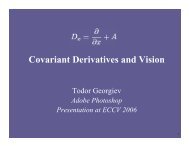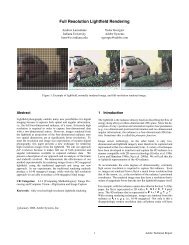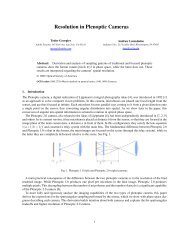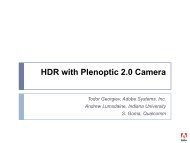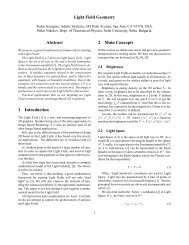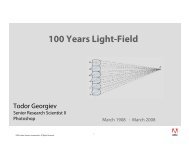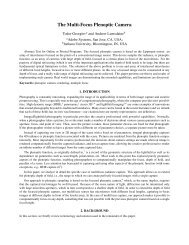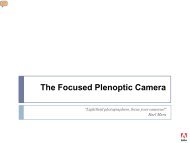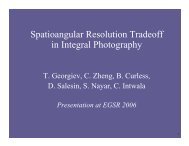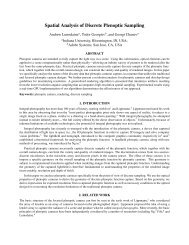Covariant Derivatives and Vision - Todor Georgiev
Covariant Derivatives and Vision - Todor Georgiev
Covariant Derivatives and Vision - Todor Georgiev
Create successful ePaper yourself
Turn your PDF publications into a flip-book with our unique Google optimized e-Paper software.
62 T. <strong>Georgiev</strong><br />
Fig. 3. The central rectangle has constant pixel values<br />
have a way to compare pixels <strong>and</strong> calculate derivatives, we can ask the question:<br />
When is a given section constant?<br />
Any section g(x, y) can be considered constant relative to appropriately chosen<br />
adaptation Ax,Ay, such that ( ∂<br />
∂x + Ax)g = 0, <strong>and</strong> similar for y. The solution is:<br />
Ax = − 1 ∂g<br />
(9)<br />
g ∂x<br />
Ay = − 1 ∂g<br />
(10)<br />
g ∂y<br />
We are considering Retinex-type adaptation of the visual system, in which the<br />
perceived gradient is the covariant derivative. In grayscale images it is described<br />
by a vector field Ax,Ay). When the visual system is exactly adapted to the<br />
image in a given area, so that (9) <strong>and</strong> (10) are satisfied, we see constant gray<br />
image (or image matching the surrounding color). We call this state complete<br />
adaptation to the image. In practice, due to the unconscious motion of the eyes, a<br />
state of complete adaptation is very difficult to reach. Still, the idea of complete<br />
adaptation will be very useful in the following sections.<br />
3 Test Case 1: Poisson Image Editing<br />
3.1 Equations<br />
It is well known that the Laplace equation △f = 0 with Dirichlet boundary<br />
conditions is the simplest way to reconstruct (or inpaint) a defective area in an<br />
image. It can be used to remove scratches, wrinkles, or bigger unwanted objects.<br />
Let’s write the derivatives in the Laplacian △ explicitly:<br />
∂ ∂ ∂ ∂<br />
f + f =0, (11)<br />
∂x ∂x ∂y ∂y<br />
After performing the minimal substitution (7), (8), the Laplace equation (11) is<br />
converted into the covariant Laplace equation:<br />
( ∂ ∂<br />
+ Ax)(<br />
∂x ∂x + Ax)f +( ∂ ∂<br />
+ Ay)(<br />
∂y ∂y + Ay)f =0, (12)



